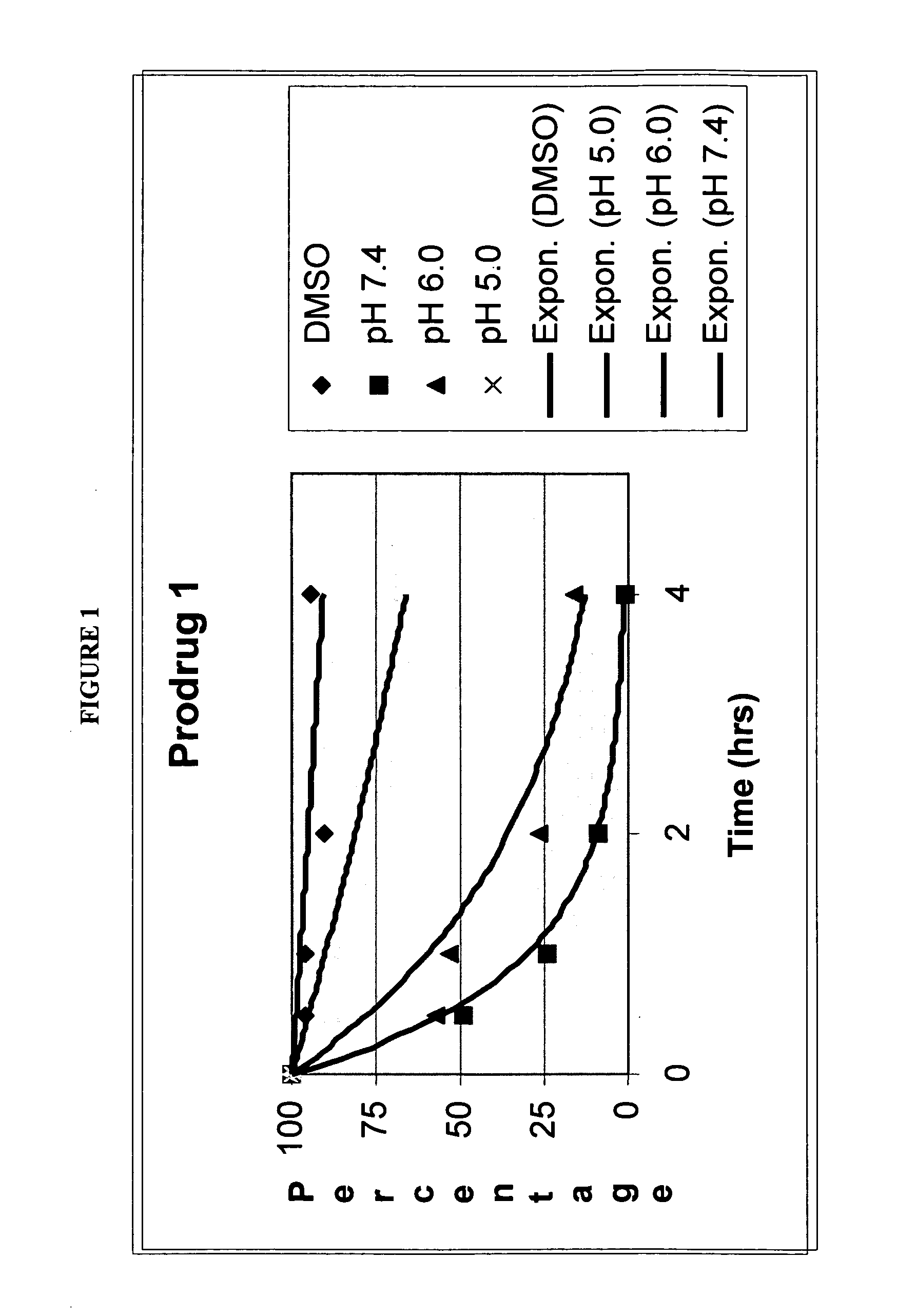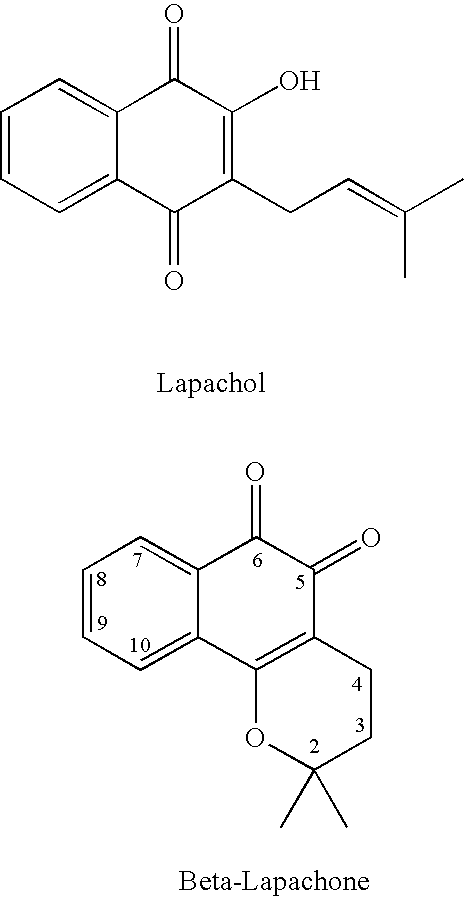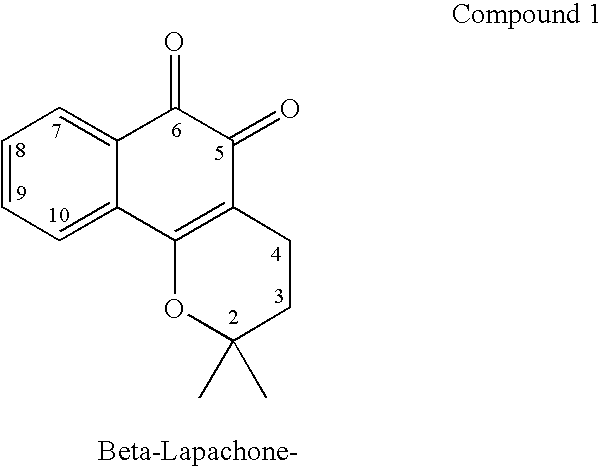Quinone prodrug compositions and methods of use
a technology of quinone and composition, which is applied in the direction of heterocyclic compound active ingredients, biocide, heavy metal active ingredients, etc., can solve the problems of low solubility of many quinone compounds, pre-cancer cell death, and cancer pre-cancer cell death, so as to improve the pharmacokinetic profile, improve the stability, and increase the aqueous solubility
- Summary
- Abstract
- Description
- Claims
- Application Information
AI Technical Summary
Benefits of technology
Problems solved by technology
Method used
Image
Examples
example 1
A. Example 1
Synthesis of 5-(acetyloxy)-2,2-dimethyl-3,4-dihydro-2H-benzo[h]chromen-6-yl N-(tert-butoxycarbonyl)glycinate (1)
[0164]
[0165] 5-(acetyloxy)-2,2-dimethyl-3,4-dihydro-2H-benzo[h]chromen-6-yl N-(tert-butoxycarbonyl)glycinate (1). A mixture of zinc dust (6.0 g, 91.7 mmol), 2,2-dimethyl-3,4-dihydro-2H-benzo[h]chromene-5,6-dione (6.0 g, 24.8 mmol), Na2S2O4 (17.26 g, 99.1 mmol), N-(tert-butoxycarbonyl)glycine (8.77 g, 49.6 mmol), triethylamine (3.1 mL, 22.3 mmol), HBTU (18.79 g, 49.6 mmol) and DMF (100 mL) is stirred for 16 hours at room temperature. To the reaction mixture is then added EtOAc (300 mL). The reaction is filtered and the filtrate washed with H2O (4×200 mL). The organic extract is dried with Na2SO4 and concentrated under reduced pressure. The residue is dissolved in acetic anhydride (30 mL) followed by the addition of zinc dust (3.0 g, 45.9 mmol) and thriethylamine (3.35 mL, 24.0 mmol). The reaction is heated at 90° C. with vigorous stirring and held for 2 hours. ...
example 2
B. Example 2
Synthesis of 5-(acetyloxy)-2,2-dimethyl-3,4-dihydro-2H-benzo[h]chromen-6-yl glycinate hydrochloride (2)
[0166]
[0167] Synthesis of 5-(acetyloxy)-2,2-dimethyl-3,4-dihydro-2H-benzo[h]chromen-6-yl glycinate hydrochloride (2—Prodrug 1): To a solution of 5-(acetyloxy)-2,2-dimethyl-3,4-dihydro-2H-benzo[h]chromen-6-yl N-(tert-butoxycarbonyl)glycinate (1) (2.35 g, 4.0 mmol) in 1,4-dioxane (25 mL) is added a solution of hydrogen chloride gas in anhydrous 1,4-dioxane (4.0 M, 60 mL). The reaction is stirred at room temperature for 6 hours. The reaction is dried under reduced pressure. The product is obtained as a white solid (1.489 g, 95%) M.p.=176-178° C.; 400 MHz 1H NMR (DMSO-d6) δ: 8.58 (br. s, 3H), 8.14 (m, 1H), 7.9 (m, 1H), 7.55 (m, 2H), 4.41 (s, 2H), 2.62 (t, J=6.6 Hz, 2H), 2.41 (s, 3H), 1.88 (t, J=6.6 Hz, 2H), 1.39 (s, 6H); LCMS: 344 [M+H]; Calc. for C19H21NO5.1.25 HCl: C, 58.62; H, 5.77; N, 3.6; Found C, 58.7; H, 5.72; N, 3.47.
example 3
C. Example 3
Synthesis of 5-(acetyloxy)-2,2-dimethyl-3,4-dihydro-2H-benzo[h]chromen-6-yl N-(tert-butoxycarbonyl)-L-alaninate (3) and 6-(acetyloxy)-2,2-dimethyl-3,4-dihydro-2H-benzo[h]chromen-5-yl N-(tert-butoxycarbonyl)-L-alaninate (4)
[0168]
[0169] 5-(acetyloxy)-2,2-dimethyl-3,4-dihydro-2H-benzo[h]chromen-6-yl N-(tert-butoxycarbonyl)-L-alaninate (3) and 6-(acetyloxy)-2,2-dimethyl-3,4-dihydro-2H-benzo[h]chromen-5-yl N-(tert-butoxycarbonyl)-L-alaninate (4). The compounds 5-(acetyloxy)-2,2-dimethyl-3,4-dihydro-2H-benzo[h]chromen-6-yl N-(tert-butoxycarbonyl)-L-alaninate (3) and 6-(acetyloxy)-2,2-dimethyl-3,4-dihydro-2H-benzo[h]chromen-5-yl N-(tert-butoxycarbonyl)-L-alaninate (4) are synthesized as described in example 1 using zinc dust (2.0 g, 30.5 mmol), 2,2-dimethyl-3,4-dihydro-2H-benzo[h]chromene-5,6-dione (2.0 g, 8.26 mmol), Na2S2O4 (5.75 g, 33.0 mmol), N-(tert-butoxycarbonyl)-L-alanine (3.12 g, 16.51 mmol), triethylamine (1.04 mL, 7.43 mmol), HBTU (6.26 g, 16.5 mmol) and DMF (20 mL)...
PUM
| Property | Measurement | Unit |
|---|---|---|
| water-solubilizing | aaaaa | aaaaa |
| pharmaceutical composition | aaaaa | aaaaa |
| compositions | aaaaa | aaaaa |
Abstract
Description
Claims
Application Information
 Login to View More
Login to View More - R&D
- Intellectual Property
- Life Sciences
- Materials
- Tech Scout
- Unparalleled Data Quality
- Higher Quality Content
- 60% Fewer Hallucinations
Browse by: Latest US Patents, China's latest patents, Technical Efficacy Thesaurus, Application Domain, Technology Topic, Popular Technical Reports.
© 2025 PatSnap. All rights reserved.Legal|Privacy policy|Modern Slavery Act Transparency Statement|Sitemap|About US| Contact US: help@patsnap.com



